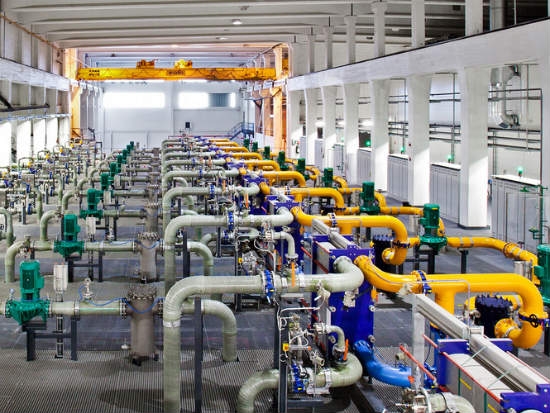 |
| Reviews and Templates for Expression We |
5 reasons the thirst for water technology will grow in 2014

Certain companies, such as beermakers Anheuser-Busch InBev and MillerCoors, have invested in serious conservation measures for years. Yet periods of drought and concerns over the energy-food-water nexus have made water a far greater topic of concern in board rooms and city halls.
Ideas for improving access are at the center of some notable corporate social responsibility initiatives. In October, for example, a coalition of companies led by Coca-Cola pledged to deliver up to 2,000 off-grid water purification systems to developing regions.
Like energy, water is a universal issue: every facility, product, community and person is touched by it somehow. As the United Nations notes: "Water scarcity is both a natural and a human-made phenomenon. There is enough freshwater on the planet for 7 billion people but it is distributed unevenly and too much of it is wasted, polluted and unsustainably managed."
Reversing that trend will take a serious annual investment: almost $840 billion, or $1.8 trillion over the next 20 years, estimates the U.N. University Institute for Water, Environment and Health (UNU-UIWEH). The good news is that this could deliver almost $3 trillion in economic, environmental and social benefits.
"As we approach some planetary tipping points, and resulting irreversible changes, innovative perspectives and paradigm shifts are necessary," said Nikhil Seth, director of the division of sustainable development at the U.N. Department of Economic and Social Affairs.
Which tipping points will matter most to your business? Here are five factors driving the urgent need for better global water efficiency.
1. Population trends translate into bursting demand
The United Nations figures that 1.2 billion people (about one-fifth of the world's population) are challenged by water scarcity. And 1.6 billion don't have access because of "economic water shortages." In other words, their communities or countries don't have the infrastructure to get clean water to its population.
By 2025, almost 1.8 billion people will be affected by "absolute" water scarcity and almost half will live in water-stressed regions. The bottom line is that water availability will be a major investment consideration in business expansion plans around the world.
Just one example from the United States: In Chandler, Ariz., Intel has negotiated a unique relationship with the city to clean and return water tainted by its wafer manufacturing operation back to the local aquifers. Chandler owns the technology to do this, but Intel has helped make that investment possible. Both sides benefit: Chandler gets jobs and a way to pay for water treatment in a community that gets an average of just 9 inches of water each year; Intel ensures a supply of ultrapure waste to keep its fab running. A crowd in Prague (Credit: Vladimir Wrangel via Shutterstock)
A crowd in Prague (Credit: Vladimir Wrangel via Shutterstock)
2. Sanitation, irrigation needs transform wastewater treatment
In September 2013, UNU-UIWEH predicts a rapid rise in the use of treated wastewater for irrigation and other needs. The water scarcity metrics cited above provide ample justification.
But right now, most wastewater is still wasted: in high-income countries, the treatment rate is 70 percent, but it falls to just 28 percent for lower-middle-income nations and 8 percent in low-income economies.
"From the earliest of times, most wastewater has truly been wasted," said Zafar Adeel, director of UNU-UIWEH. "However, it is a vast resource if we reclaim it properly, which includes the separation of municipal from industrial wastewater. Another way of envisioning the volume of the resource potentially available worldwide each year is to imagine 14 months watching the outflow from the Mississippi River into the Gulf of Mexico."
One example of why we need to rethink wastewater reuse: between 70 percent and 95 percent of the world's freshwater is used for irrigation.
Given this backdrop, there has been a heightened focus on how to "recycle" wastewater back into drinking water. It's still an expensive — and highly regulated — proposition, but more states including Texas, Nevada, Florida and Virginia are collecting wastewater for uses such as irrigation or landscaping. "Everything that goes down the drain here is treated and reused," Greg Flores, vice president of public affairs for the San Antonio Water System, told Ensia.
3. Utility costs are rising quickly
If humanitarian concerns don't excite upper management at your company, how about saving money as an argument?
Commercial water rates have risen an average of 30 percent over the past four years in the United States, according to data gathered by Ecova, which tracks metrics from more than 700,000 facilities on an ongoing basis.
One company that decided to combat this was Shari's Café & Pies, a 100-location restaurant chain in the Pacific Northwest that has seen water rates rise more than 16 percent since 2008. Shari's Café began tracking water consumption about five years ago, reducing usage in 20 restaurants by an average of 50 percent in the process. "We didn't really know how much water a location should be using until we started looking at this data," said Jodenne Scott, director of financial support services.
4. Distribution networks are aging rapidly
In established urban areas, the pipes, pumps and reservoirs are an average of 50 to 100 years old — and they are showing their age in the form of undetected leaks. In emerging economies, the infrastructure may be younger, but it is just as unreliable. Overall, the World Bank estimates the annual global value of water lost by utilities at $14 billion. The average U.S. utility pours up to 30 percent down the drain through leaks or un-billed usage.
Little wonder that annual revenue from smart water meters will surpass $3.3 billion by 2022, according to a forecast by Navigant Research. "The water industry is hungry for change, but conservative in its operations and restricted by its financial options," said Eric Woods, research director with Navigant. "Smart water networks are an intrinsic part of the transition of the industry to a data-centric business that is able to maximize the benefits of intelligent devices, IT and communications networks."
It's telling that the winner of this year's Sustainia Award, which recognizes technologies and solutions that address a pressing global sustainability need, was TaKaDu, a company that has dedicated itself to monitoring water grids and proactively warning about leakage, burst pipes and other irregular consumption patterns that could signal a bigger problem.
Although the company doesn't currently work with any U.S. utilities, it has made progress in Australia, Chile, Israel, Portugal, Spain and other countries in both Europe and Latin America, said CEO Amir Peleg. In October, the 3M corporate venture capital arm made an undisclosed investment in the company, joining ABB.
"TaKaDu's novel solution is unique in combining a big data approach, closed-based service and strong IP," said Ryan Rogers, global business manager-water infrastructure renewal for the electrical markets division of 3M. "It is cost-effective to implement and can quickly pinpoint and address issues as they arise, arming the water network manager with new knowledge and insight to help them address water loss and improve the effectiveness of their maintenance organization, allowing for higher customer satisfaction." This data center in Finland uses seawater cooling. (Credit: Google)
This data center in Finland uses seawater cooling. (Credit: Google)
5. Data centers guzzle more water
Most technology managers are pretty familiar with the concept of power usage effectiveness (PUE), which measures the ratio of electricity needed for equipment to cool IT infrastructure versus the amount of power it takes to run the technology itself.
Far fewer are familiar with water usage effectiveness (WUE), a metric that looks at how many liters of water go into running and cooling them.
This year, however, Facebook began shining a more visible light on the WUE measure by publishing real-time dashboards that keep tabs on how its data centers in Oregon and North Carolina perform against these measures. At the end of the third quarter, its WUE for Prineville, Ore., was 0.49 liters per kilowatt-hour. Its design eliminates cooling towers and centralized chillers in favor of outside air cooling (an approach that also improves the PUE metric).
How good is that measure? No one really knows, because very few data center operators are really tracking the water metric closely. That's something that some researchers with Florida International University are hoping to change. They point out that a 15-megawatt data center using cooling towers could guzzle up to 360,000 gallons of water daily (and that excludes the water needed to generated the power for the facility). The NSA facility in Utah uses far more: almost 1.7 million gallons.
"Although some of the largest data center operators (such as Google and Microsoft) have begun to slash their onsite cooling water usage, the overall water footprint (including both onsite and offsite water) is still one of the forgotten aspects of cloud computing from the perspective of sustainability," said Shaolei Ren, an assistant professor at the university's School of Computing and Information Sciences, in some of his research into the area.
"In fact, while we've been talking for years about saving energy/electricity cost/carbon footprint and undoubtedly we've made a remarkable progress (e.g., lowering PUE from 2.0 to less than 1.1), water footprint in data centers has received incredibly less attention from the research community, silently presenting an emerging challenge to water sustainability."
The team's research page offers a compendium of resources that could help change that equation.
|
|
|
|
Copyright 2011 Energy and Technical Services Ltd. All Rights Reserved. Energyts.com |